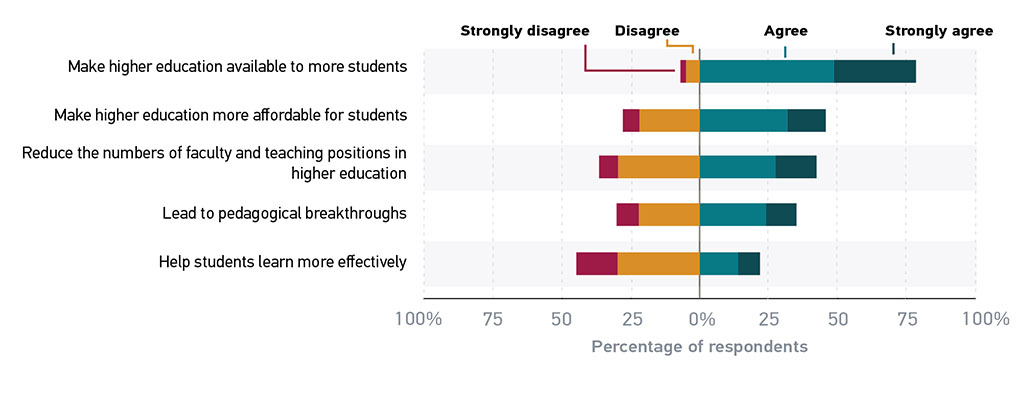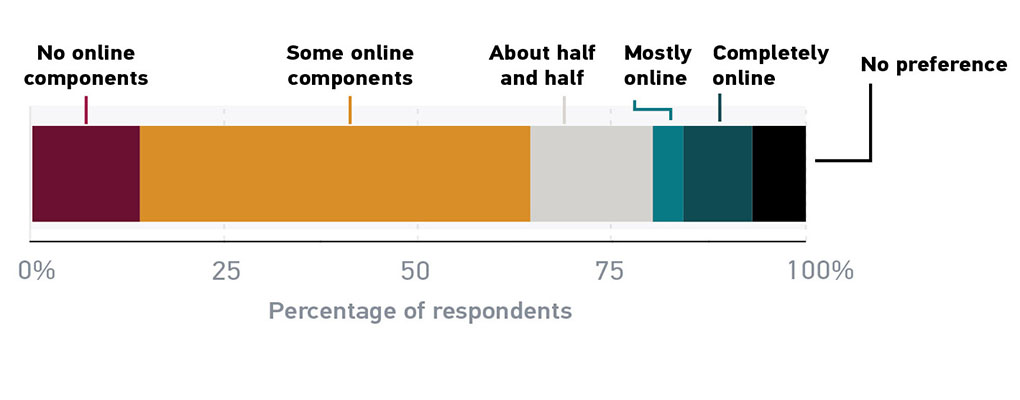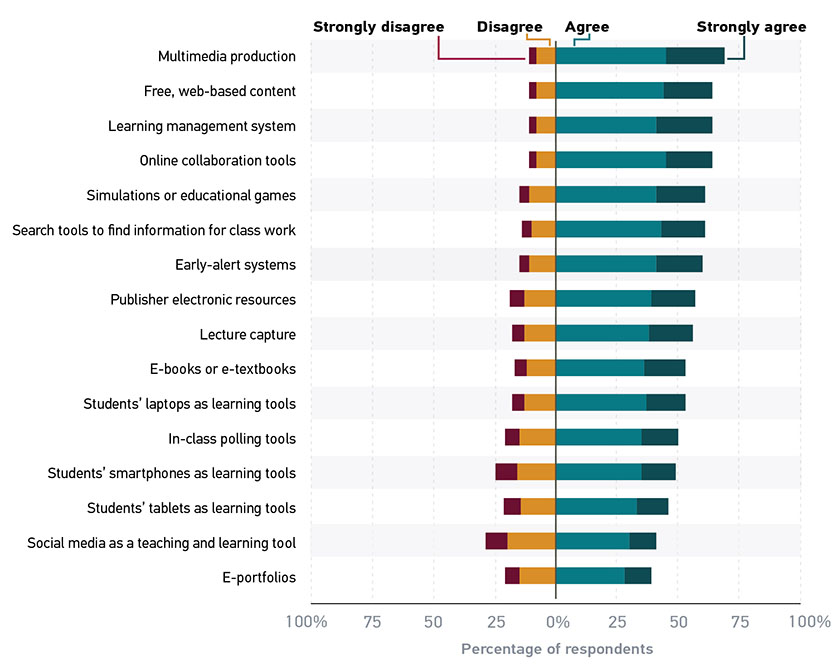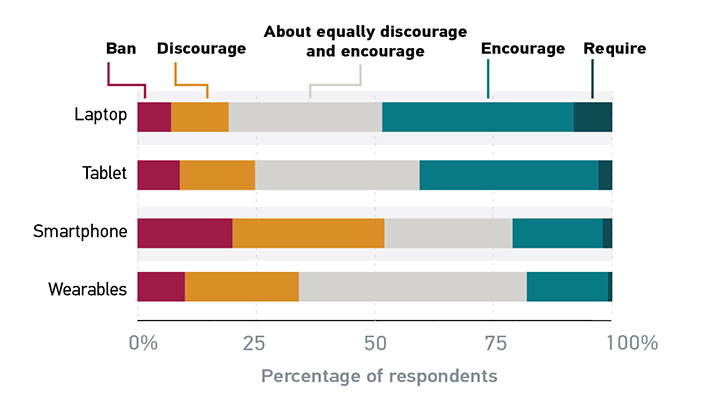Technology and Learning Environment
Online Teaching
Faculty were asked how many for-credit course sections they had taught in the past 12 months. Respondents who had taught zero course sections in the past 12 months must have been on leave or had bought out of their courses yet were still motivated to respond to our survey. (We thank you, whoever you are.) Perhaps unsurprisingly, most of those with the heaviest teaching loads are lecturers or instructors. The median number of course sections taught by respondents in the past 12 months was 6, which is a reasonable number for instructors at institutions where the academic calendar is based on either semesters or quarters. A follow-up question asked for the number of for-credit course sections respondents had taught in the past 12 months and the varying degrees of blendedness of face-to-face and online modalities.
There is no agreed-upon measure of blendedness. The Courseware in Context (CWiC) Framework and the OLC Blended Learning Scorecard articulate categories of the course environment that may be online. However, even these tools do not quantify the extent of blendedness of these categories. The distinction between these modalities is therefore quite fuzzy. That said, most course sections taught in the past 12 months were completely or mostly face to face, some were completely online, and few were blended to any significant extent. This perhaps indicates the fact that entirely online courses and programs are widespread in higher education but that faculty, by and large, are not providing their students in the classroom with a blended learning experience by using the tools available to them. Certainly this is true for the LMS, which, as discussed above, faculty use largely for operational, course management functions and very little for interactivity.
Opinions about Online Learning
By and large, faculty do not seem to have a very positive opinion of online learning. Faculty were asked the extent to which they agree with a small set of statements about online learning. As shown in figure 10, 79% of faculty agreed or strongly agreed that online learning makes higher education available to more students. But fewer than 50% of faculty agreed or strongly agreed with any of the other statements, and almost half of faculty disagreed or strongly disagreed that online learning helps students learn more effectively. Or, put differently, almost half of faculty believe that online learning has either no effect or a negative effect on student learning.

Faculty belief that online learning has either no effect or a negative effect on student learning is simply incorrect. Barbara Means and colleagues conducted a meta-analysis of a host of studies of online learning and found that fully online courses produced learning gains that are indistinguishable from those produced in fully face-to-face environments; in fact, they found that blended instruction has stronger learning outcomes than either online or face-to-face instruction alone.1 The fact that faculty are either unaware of these findings about online learning or perhaps are unconvinced by them should be a call to arms for centers for teaching and learning at institutions with online courses or programs and for researchers evaluating efficacy research on educational technology.2
Preference for Teaching Environment
Faculty were asked in what type of learning environment they prefer to teach. The findings from this question closely parallel those reported in the “Online Teaching” section, above, about the number of for-credit course sections of varying degrees of blendedness that faculty had taught in the past 12 months. Faculty members predominantly taught courses with no or only some online components, and they prefer to teach courses with no or only some online components. Correlation does not equal causation, but it is difficult to escape the suspicion that either faculty teach mostly courses in these modalities because they prefer them or that faculty prefer these modalities because they are familiar.
As discussed above, there is no agreed-upon measure of blendedness, so the distinctions between the categories in figure 11 are quite fuzzy. That said, it is clear that the vast majority of faculty prefer to teach in an environment that is blended to a greater or lesser extent, though mostly lesser. Nevertheless, this is a positive finding, given that, as discussed above, blended instruction has stronger learning outcomes than either mode alone.3

Figure 11 shows that 9% of faculty prefer to teach in a completely online environment. Taking this finding side-by-side with the finding reported above that almost half of faculty believe that online learning has either no effect or a negative effect on student learning points to a division among faculty: Of faculty who prefer to teach in an environment with no online components, 70% disagreed or strongly disagreed that online learning helps students learn more effectively. On the other hand, of faculty who prefer to teach in a completely online environment, 59% agreed or strongly agreed that online learning helps students learn more effectively.4 In short, faculty seem to be self-selecting into the teaching modalities they believe in or for which they are rewarded by their institution or their discipline. Those who believe in the pedagogical power of online learning teach online, while those who don’t, don’t.
Integration of Technology into Teaching
Technology is ubiquitous in higher education and increasingly integrated into teaching and learning. Students say that they want more and better uses of technology in the classroom.5 Given this student demand, it is critical to identify what factors can lead faculty to integrate more technology into their teaching.
Respondents were presented with a list of learning technologies and asked to rate their level of agreement with the statement “I could be a more effective instructor if I were better skilled at integrating this technology into my courses.”6 These technologies spanned a wide range, from the nearly ubiquitous smartphones and LMSs to those currently occupying more of a specialized niche, such as educational games; and from commercial offerings such as publisher-created resources to free resources such as OER and content from the Khan Academy.
Figure 12 shows that between one-third and two-thirds of respondents agreed or strongly agreed that they could be more effective if they were better skilled at integrating every single one of the technologies listed into their courses. At the very top of the list, at 69%, is video- and multimedia-production software. This is perhaps a result of the dramatic decrease in the cost and the increase in the availability and ease of use of video-editing software over the past few years. It is perhaps also a result of the hype around MOOCs over the past few years; while not having lived up to the hype in many ways, MOOCs have certainly raised the stakes for video production values in blended courses.7 In 2016, the Gartner Hype Cycle for Education listed MOOC platforms as “On the Rise.”8 This desire by faculty to have greater skill in video and multimedia production may be an indication that MOOCs, and perhaps the flipped classroom model more generally, have leapt straight to the “Slope of Enlightenment,” as good practices in creating educational video are evolving.

To the extent that the technologies in figure 12 contribute to blended learning, this finding somewhat contradicts the finding discussed above about faculty preference for teaching environments. Only a few of these technologies are specifically learning environments in which faculty might teach, though those are very near the top of this list: the LMS, online collaboration tools, and educational games. All of these technologies, however, enable blended learning to some extent. It is therefore worth pointing out that when asked about the type of learning environment in which they prefer to teach, faculty members said they prefer few or no online components, but when asked about specific tools and technologies whose use would make their courses blended, faculty members believe that their teaching would improve by their use.
This rejection of the forest but acceptance of the trees makes it clear that there remains some misunderstanding among faculty about just what online or blended teaching and learning entails. Again, there is still much work to do to educate faculty about the strong learning outcomes of blended instruction. There is an opportunity here for providing professional development to faculty. Such training may be offered by an institution’s central IT unit or a center for teaching and learning, or some partnership of these campus units. Furthermore, as nearly three-quarters of faculty use their institution’s help desk services when they need technology support, there is a clear avenue for providing training to faculty in integrating technology into their courses.
At the bottom of the list are those technologies that the greatest percentage of respondents disagreed would make them more effective: social media and smartphones. As reported in the student study, 97% of students own smartphones, 83% of students used a smartphone for one or more of their courses, and half of students consider it very or extremely important to their academic success. Moreover, as reported in the “Device Ownership” section, 93% of faculty personally own a smartphone. Given that smartphones are ubiquitous and so extensively used by students for academic purposes (and have been for so long9 ), there is a clear opportunity here for instructional designers to help faculty gain a better understanding of how to use these devices for teaching and learning.
The question about integrating technology into courses was followed by a question about factors that would motivate the respondent to integrate more or better technology into their teaching practices or curriculum.10 At the top of that list, selected by more than one-third of respondents, were “Clear indication/evidence that students would benefit” and “Release time to design/redesign my courses.”
Clear evidence of the efficacy (or lack thereof) of some of these technologies for learning is only starting to emerge—for example, research on student early-alert systems.11 And the evidence that does exist for some of these technologies is highly context-dependent, as with research on educational games.12 That said, as discussed above, there is a great deal of evidence about the efficacy of many educational technologies.13
Provosts and other members of the institutional administration need to be aware that faculty want release time for redesigning their courses to integrate technology. Student success is of course central to the mission of all institutions of higher education. Given that blended instruction has stronger learning outcomes than face-to-face instruction alone,14 institutions should be doing everything they can to motivate faculty to integrate more and better technology into their teaching. Release time is expensive for an institution, but it would behoove institutions to set some funds aside for this purpose.
Another way in which institutions can motivate faculty to integrate technology into their teaching is by providing more support for doing the work of this integration. Nearly one-quarter of respondents indicated that “Direct assistance from IT staff to support the technology I choose to implement” and “Direct assistance from an instructional design expert” would be motivating for them. This is a clear opportunity for both IT units and centers for teaching and learning—independently or collaboratively—to provide a high-touch consulting-like service to faculty.
Policies on Mobile Devices
As discussed in the “Integration of Technology into Teaching” section, approximately half of faculty agreed or strongly agreed that they could be more effective if they were better skilled at integrating students’ laptops, tablets, and smartphones into their courses. (We did not ask about wearables in that section of the survey.) Yet a significant percentage of faculty either discourage or outright ban these devices from their classroom.
Note that faculty members’ self-reports about their classroom policies do not match students’ reports of their instructors’ classroom policies. As figure 13 shows, half of faculty say that their policy is to encourage or require laptops, but only a third of students report that this is the case.15 Half of faculty said that they discourage or ban smartphones from the classroom, but two-thirds of students said that their instructors do so. It is not quite clear what explains this discrepancy: Are students misunderstanding their instructors’ policies? Do students more readily recall the more restrictive policies? Are faculty members’ responses to this question suffering from social desirability bias?

In any event, it should come as no surprise that faculty beliefs about the usefulness of a device as educational technology are associated with classroom policies about that device. Across the board, faculty members who believe that they could be more effective instructors if they were better skilled at integrating a device into their courses are more likely to have policies encouraging or requiring its use in the classroom. The converse is also true—faculty who disagree that they could be more effective if they were better skilled at integrating a device into their courses are more likely to have policies discouraging or banning its use in the classroom.
Similarly, faculty policies regarding devices are associated with the type of learning environment they prefer to teach in. Obviously, in courses that are completely online, students must use a device. Even in blended courses, however, the greater the degree of blendedness (some online components, about half and half, or mostly online), the more likely the faculty member is to encourage or require students to use all of the devices in figure 13.
Furthermore, faculty policies regarding laptops and tablets are associated with the faculty member’s age, though not in the direction one might expect: Older faculty members are more likely to encourage or require students to use a laptop or a tablet in the classroom.
This finding, however, may not be strictly about faculty members’ age. While greater age does not necessarily mean a larger number of years as a faculty member, faculty members’ policies regarding devices are also associated with the number of years in a faculty position. A recent study of faculty members found that one of the strongest disincentives to innovation in the classroom is a fear of embarrassing themselves in front of students.16 Fundamentally, this is a matter of a faculty member’s level of skill in classroom management: The longer faculty have been teaching, generally the greater their skill in classroom management, and the greater their skill in classroom management, the less fear they would have of embarrassing themselves in front of students. In short, faculty who are more confident in their classroom management skills are more likely to encourage or require students to use devices in the classroom.
Faculty attitudes about educational technology are also associated with their policies about devices in the classroom. As all students know, some faculty are more willing to experiment with technology than others. The fact that classroom policies are not significantly associated with the type of institution (Carnegie class, institutional size, enrollment, or complexity index17), however, seems to indicate that these policies are largely idiosyncratic to faculty members and have little to do with the institution, its policies, or level of support for technology. This finding is supported by the association of classroom policies with faculty members’ age. Research outside academia has found that age is associated with innovative behavior in organizational settings,18 so to the extent that encouraging the use of devices in the classroom can be considered innovative, it is to be expected that senior faculty members would do so at a greater rate than junior faculty. Research within academia has found that “reward systems for faculty members, particularly untenured ones, are not aligned with institutional aspirations” toward innovation,19 thus reinforcing the association of age and innovative behavior among faculty.20
Notes
-
Barbara Means, Marianne Bakia, and Robert Murphy, Learning Online: What Research Tells Us about Whether, When and How (New York: Routledge, 2014); Barbara Means, Yukie Toyama, Robert Murphy, Marianne Bakia, and Karla Jones, Evaluation of Evidence-Based Practices in Online Learning: A Meta-Analysis and Review of Online-Learning Studies (Washington, D.C.: U.S. Department of Education).
↩︎ -
Goldie Blumenstyk, “Which Ed-Tech Tools Truly Work? New Project Aims to Tell Why No One Seems Eager to Find Out,” Chronicle of Higher Education, July 21, 2016.
↩︎ -
Barbara Means, Marianne Bakia, and Robert Murphy, Learning Online: What Research Tells Us about Whether, When and How (New York: Routledge, 2014); Barbara Means, Yukie Toyama, Robert Murphy, Marianne Bakia, and Karla Jones, Evaluation of Evidence-Based Practices in Online Learning: A Meta-Analysis and Review of Online-Learning Studies (Washington, D.C.: U.S. Department of Education).
↩︎ -
This finding is consistent with the results of an APLU study of faculty opinions about online learning: “Faculty with experience developing or teaching online courses have a much more positive view towards online instruction than those without such experience. Faculty with no online experience remain relatively negative about online learning outcomes.” Jeff Seaman, Online Learning as a Strategic Asset, Association of Public and Land-grant Universities, 2009.
↩︎ -
D. Christopher Brooks and Jeffrey Pomerantz, ECAR Study of Undergraduate Students and Information Technology, 2017, research report (Louisville, CO: ECAR, October 2017).
↩︎ -
Responses to this question were on a 5-point Likert-type scale, ranging from “strongly disagree” to “strongly agree.”
↩︎ -
Leonard J. Waks, The Evolution and Evaluation of Massive Open Online Courses: MOOCs in Motion (New York: Palgrave Pivot, 2016).
↩︎ -
Jan-Martin Lowendahl, “Hype Cycle for Education, 2016,” Gartner, July 1, 2016. MOOC platforms mysteriously vanished entirely from Gartner’s 2017 Hype Cycle for Education: Kelly J. Calhoun Williams, “Hype Cycle for Education, 2017,” Gartner, July 24, 2017.
↩︎ -
Yvonne Belanger, Duke University iPod First Year Experience Final Evaluation Report, June 2005.
↩︎ -
Respondents were asked to select up to three factors.
↩︎ -
Eden Dahlstrom and Jacqueline Bichsel, ECAR Study of Undergraduate Students and Information Technology, 2014, research report (Louisville, CO: ECAR, October 2014).
↩︎ -
Luis de-Marcos, Eva Garcia-Lopez, and Antonio Garcia-Cabot, “On the Effectiveness of Game-Like and Social Approaches in Learning: Comparing Educational Gaming, Gamification & Social Networking,” Computers & Education 95 (April 2016): 99–113; Anja Hawlitschek and Sven Joeckel, “Increasing the Effectiveness of Digital Educational Games: The Effects of a Learning Instruction on Students’ Learning, Motivation and Cognitive Load,” Computers in Human Behavior 72 (2017): 79–86.
↩︎ -
Barbara Means, Marianne Bakia, and Robert Murphy, Learning Online: What Research Tells Us about Whether, When and How (New York: Routledge, 2014); Goldie Blumenstyk, “Which Ed-Tech Tools Truly Work? New Project Aims to Tell Why No One Seems Eager to Find Out,” Chronicle of Higher Education, July 21, 2016.
↩︎ -
Barbara Means, Yukie Toyama, Robert Murphy, Marianne Bakia, and Karla Jones, Evaluation of Evidence-Based Practices in Online Learning: A Meta-Analysis and Review of Online-Learning Studies (Washington, D.C.: U.S. Department of Education).
↩︎ -
See the “Uses, Abuses, and Consequences of Classroom Device Use” section of the student study.
↩︎ -
David Matthews, “Fear of Looking Stupid,” InsideHigherEd, July 6, 2017.
↩︎ -
Johan Bergström, Eden Dahlstrom, Pekka Kähkipuro, Anne Kealley, Leah Lang, Lori MacMullen, Michele Mennielli, Paul Sherlock, and Peter Tinson, Benchmarking IT: A Global Approach (Louisville, CO: ECAR, July 15, 2015).
↩︎ -
Thomas W. H. Ng and Daniel C. Feldman, “A Meta-Analysis of the Relationships of Age and Tenure with Innovation-Related Behaviour,” Journal of Occupational and Organizational Psychology 86, no. 4 (2013): 585–616.
↩︎ -
Paul R. Sanberga, Morteza Gharib, Patrick T. Harker, Eric W. Kaler, Richard B. Marchase, Timothy D. Sands, Nasser Arshadi, and Sudeep Sarkar, “Changing the Academic Culture: Valuing Patents and Commercialization toward Tenure and Career Advancement,” PNAS 111, no. 18 (2014): 6542–6547.
↩︎ -
The average age for earning tenure in the U.S. is 39. See USA, Academic Career Structure.
↩︎